Jun 26, 2010
Climate Change Delayers Topple Rudd
Tom Arup
Julia Gillard has made no concrete commitment on when to put a price on carbon emissions, despite former Prime Minister Kevin Rudd urging his party to try passing an emissions trading scheme after the election.
Speaking after she had toppled Mr Rudd yesterday, Ms Gillard said she would now work to build a public consensus for a carbon price ‘’as vigorously as I can and as long as I need to.’’
‘’I will do this because I believe in climate change,’’ she said, ‘’I believe human beings contribute to climate change.’’
In April, the government delayed its emissions trading scheme until at least 2013, sparking a massive collapse in public support for Labor and Mr Rudd in opinion polls.
In his final statement as Prime Minister yesterday, Mr Rudd said he was proud of the fact the government tried three time to pass an emissions trading scheme, ‘’although we failed.’’
‘’And, if I had one point of future policy, it must be our ambition to pass a carbon pollution reduction scheme within this parliament, the one that follows, I mean, so that we can make a difference, a real difference, to climate change,’’ Mr Rudd said.
His comments are being interpreted as a parting shot at the ALP’s New South Wales right-wing faction, led by Senator Mark Arbib, who pushed for the government to dump the emissions trading scheme.
Senator Arbib and the NSW Right were also instrumental in bringing down Mr Rudd’s leadership.
A final decision to shelve the emissions trading scheme until 2013 was made in April by a cabinet subcommittee made up of Mr Rudd, Ms Gillard, Treasurer Wayne Swan and outgoing Finance Minister Lindsay Tanner.
Ms Gillard and Mr Swan - now Deputy Prime Minister - both actively campaigned within the government to defer the emissions trading scheme.
Ms Gillard said yesterday she did not want to ‘’in any way seek to diminish my role in making that decision’’.
‘’I came to that decision because I fundamentally believe that if you are going to restructure our economy so that we can deal with a carbon price and deal with all of the transformations in our economy that requires, then you need community consensus.’’
Story here. Another is here. See Andrew Bolt destroy the know nothing alarmist Flannery in this interview here.
Jun 24, 2010
23 Jun - Heavy snow for Europe’s glaciers plus more Southern Hemisphere resorts open
If You Ski
* Up to 30cm (a foot) of new snow so far today around Queenstown’s ski areas.
* Up to 50cm (20 inches) of fresh snow in the Alps.
* Second Californian ski area to open in July.
* Cairngorm in Scotland wraps up seven month season.
* Argentina’s resort start to open and more snow in Chile and South Africa.
Ski Info reports that more of Europe’s glacier ski areas are opening and that they, along with the centres already open, are benefitting from heavy snowfalls in recent days.
More ski areas have also been opening in the southern hemisphere, where resorts in New Zealand are reporting up to 25cm of new snow so far today. In addition a third US area has announced plans to open its slopes in July.
There have been low temperatures and heavy snow on glaciers in the Alps in the past few days. With all three summer ski areas now open in France, this means 10 areas are offering powder snow conditions on their slopes at the moment! In Austria the Hintertux glacier has reported 45cm (18 inches) of new snow it has a 590m vertical with 20km of pistes open, and a 195.cm (6.5 foot) base. The Dachstein glacier has a210cm (7 foot) base and is reporting powder conditions. It’s beginner park and super park are both open. The Kitzsteinhorn glacier above Kaprun has also reopened, reporting another 5cm (two inches) of fresh snow on Tuesday, on top of weekend falls and a full 750 metres of skiable vertical. The Molltal glacier will re-open this Sunday, 27 June at 8am with about 9 km of groomed slopes open daily to 4pm through to the end of August. The centre currently reports up to 3.6m (12 foot) snow depths on the glacier.
Italy will also be up to four summer ski areas open by the weekend when Cervinia re-opens with fresh snow. It will join the still-open Presena glacier above Passo Tonale where just two advanced to expert runs are open, as well as Passo Stelvio and Val Senales, which has reported 20cm of new snow in two falls over the past few days. In Switzerland it’s still only Zermatt, Europe’s highest ski area, which has 8km of runs open.
In France the ski lifts began running again at the weekend at Tignes on the Grande Motte glacier and in neighbouring Val d’Isere which joined Les 2 Alpes which re-opened a week ago. In Tignes there’s 20km of piste and a giant terrain park open, the snow base is 120cm (four feet) and there’s been another 5cm of fresh snow. The slopes are open from 7:15am to 1pm, and located at an altitude ranging from 3,000 to 3,456 metres. The glacier features 12 ski lifts and can be accessed in seven minutes by the underground funicular. Les 2 Alpes has 80cm (2.6 feet) of snow at 2600m and 2.8m (over 9 feet) up at 3200m with 12 slopes and the terrain park open at one of Europe’s largest summer ski areas.
The only other places to ski in Europe are in Norway, where three glacier ski areas are open at Folgefonn with up to four metres of snow lying, Galdhoppigen with up to five metres of snow lying and Stryn with up to 4.5 metres of snow lying.
In Scotland more than 60 skiers took to the slopes at CairnGorm Mountain on the summer solstice on Monday 21st June 2010 to enjoy some midsummer skiing on the snow still lying there in the Ptarmigan bowl. They were able to take advantage of the two rope tows which had been set up there by the resort’s operators CairnGorm Mountain Ltd. Skiers had travelled from as far away as the Isle of Mull in order to be able to say that they had skied at midsummer at CairnGorm. The 21st was the 147th day of skiing at CairnGorm since the season started on 28 November 2009 and brings to 145,007 the total number of skier days at the resort in what by any account has been an extraordinary season. There were 23 days when skiing was not possible due to high winds or access blocked by snow. Last year 65,000 skiers visited the resort and only three years ago they had their worst season ever with only 38,000 skiers.
In North America the ski season ended a weekend later than expected in Utah when Snowbird decided to open last weekend after all, extending their 2009/10 season to 189 total days. Customers were limited to one ride up the Aerial Tram per day, allowing access to Little Cloud lift and skiing on Regulator Johnson. All additional terrain was closed and classified as “backcountry terrain.”
However Timberline on Mt Hood in Oregon and Mammoth Mountain in California are still operating their ski lifts and snow slopes.
Mammoth, which currently has 2-6 feet (60-180cm) of snow has previously said they’ll stay open for two more weekends to July 4. However another California resort, Boreal, has now said they’ll open for one weekend only, on the 10th/11th July. Lifts will be open from 10am - 2pm, to enjoy the abundance of snow left from the snowy spring. A full terrain park will be built, accessed via the Castle Peak Quad and lift tickets will cost 20 dollars. North of the border Whistler’s summer skiing and boarding area on the Blackcomb glacier is now open and the resort is also offering summer snowshoeing and tubing.
In South America Las Lenas is the first resort to open in Argentina has opened with a metre of snow on upper slopes, but the country’s other leading resort, Catedral, says it needs more snow before opening, there’s currently about a foot (30cm) on upper slopes. Conditions at most ski areas in Chile are looking good after the centres there reported receiving up to two feet (60cm) of snow in the past week, most of it just before the weekend. Chapa Verde has a 60cm (two foot) base and Chapelco 50cm (20 inches).
However Valle Nevado and the South American ‘ three Valleys’ that surround it have some of the best conditions on the continent with more than 1.6m (over five feet) of accumulated snowfall to date. Portillo, which delayed its opening by a week, is now on schedule to open this weekend.
In southern Africa there’s snow sports as well as World Cup football. Africa’s Tiffindell is open for skiing and Afriski in Lesotho has had more new snow taking its base depth to 65cm (2.2 feet) with a 400m long slope open.
In Australia there’s been no new natural snowfall for over a week now but temperatures are continuing to stay quite low so most resorts with snowmaking are making more, and resorts like Falls Creek, Mt Hotham and Perisher have 40 or 50cm (16-20 inches) of snow on snowmaking areas, Thredbo has a little less.
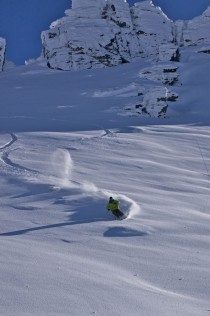
More ski areas have been opening in New Zealand. Treble Cone, which has received excellent pre-season snow, will open tomorrow (Thursday 24 June) with the first lift running at 8.30am. There’ll be Amisfield bubbles for the first 150 skiers on the lifts. Whakapapa is scheduled to open on Saturday 26th June.
Of the already-open areas, Turoa has 80cm (nearly three feet) of snow on upper slopes. The Remarkables has 85cm (nearly three feet) and has reported 10cm (four inches) of new snow earlier today. Coronet Peak has the same amount lying and 15cm (six inches) of new snow so far today. But Mt Hutt has trumped both with 25cm (10 inches) of new snow today and a metre (3.3 foot) base.
After getting their first turns of the season on Treble Cone’s feeride terrain, skiers and snowboarders can spend the afternoon testing their aerial skills on The AirBag. The AirBag is a supersized, air-filled stunt cushion that provides a soft landing for skiers and snowboarders. The first time it has been seen in on-snow in New Zealand, The Airbag is used throughout Europe to develop the training techniques of Olympic and national aerial teams.
The giant 10mx15m cushion will be in full view of the Treble Cone deck and high-speed six seater chairlift for onlookers to check out all the aerial action as some of the region’s top pro freeskiers and snowboarders put it through its paces. See post here. (Thanks for tip from Roger Pielke Sr.)
Jun 21, 2010
How to Expose a Warmist: Andrew Bolt Interviews Australia’s Al Gore
By Tom Minchin
The global warming movement is in heavy retreat in every Western country. But, as we have learned from the rise of leftist leaders like President Obama and Australia’s Prime Minister Kevin Rudd, modern collectivists are resilient. If they can recover from the collapse of Communism, they can certainly rebuild the environmental movement. Now is not the time to celebrate, but to press home the exposure of their bogus claims and hidden interests.
TIA Daily readers will therefore appreciate the uncompromising interview style of Australian journalist Andrew Bolt as he eviscerates one of the world’s leading warming alarmists, Tim Flannery-a man in the mold of Al Gore. The interview took place on radio in Melbourne, Australia on June 9. Andrew Bolt has given TIA Daily permission to reproduce the interview in full. The debate begins with Bolt asking Flannery about his disillusionment with the Australian government over its ditching of Cap and Trade:
Flannery: I’m unlikely to vote for him [Rudd] because my trust has been eroded away.... He promised to deliver an emissions trading scheme and he’s then withdrawn that with very little justification....
Bolt: He said he wouldn’t move now until the rest of the world did something which is a direct repudiation of what he said before. But, Tim, part of the reason, of course, that he’s backed down is that there’s been a great swing in sentiment against this kind of thing, there’s a rising tide of skepticism. How much are you to blame for some of that?
Flannery : There is some swing in sentiment. And I think it’s very hard to maintain any issue with that sort of very high level of support for a long time. So there’s some, but what is happening around the world should give us all heart. We’ve seen China now pledged to reduce is emissions intensity by over 40 per cent.
Bolt: It’s still going to build a coal-fired power station every week or so.
Flannery: And what that is going to do if that’s achieved by 2020 is put us on track to avoid dangerous climate change. But for us to do that, places like Australia and the US, the wooden spooners in this debate, actually have to do their part.
Bolt: But, Tim, I’m just wondering, there has been a rise in skepticism. That’s precisely why the Liberals [the Australian Liberal party is closer to the classical pro-free market 19th-century meaning of that term rather than its modern sense], for example, have switched from supporting an ETS to opposing it...and they dumped their leader over it. Now I’m wondering to what extent are you to blame for rising skepticism about some of the more alarming claims about global warming.
Flannery : Well, many of the things that scientists highlight may happen are very alarming. They’re not alarmist but they are worrisome. Rises in sea-levels, for instance, are a significant issue.
Bolt: Well, let’s go through some of your own claims. You said, for example, that Adelaide may run out of water by early 2009. Their reservoirs are half full now. You said Brisbane would probably run out of water by 2009. They are now 97 per cent full. And Sydney could be dry as early as 2007. Their reservoirs are also more than half full. How can you get away with all these claims?
Flannery: And thankfully, Andrew, governments have taken that to heart and been building some desalination capacity such as in Perth.
Bolt: Only in Perth.
Flannery: No, there’s plans in every capital city.
Bolt: No, no, no, you said Brisbane would run out of water possibly by as early as 2009. There’s no desalination plant, there’s no dam.
Flannery: What I have said is that there is a water problem. They may run out of water. And ...
Bolt: 100 per cent full, nearly! 100 percent full.
Flannery: That’s a lie, Andrew. I didn’t say it would run out of water. I don’t have a crystal ball in front of me. I said Brisbane has a water problem.
Bolt: I’ll quote your own words: “Water supplies are so low they need desalinated water urgently, possibly in as little as 18 months.” That was, on the timeline you gave, by the beginning of 2009. Their reservoirs are now 97 per cent full.
Flannery: Yeah, sure. There’s variability in rainfall. They still need a desal plant.
Bolt: You also warned that Perth would be the 21 century’s first ghost metropolis.
Flannery: I said it was...may.
Bolt: It’s all “may.” Right?
Flannery: Because at that stage there had been no flows into that water catchment for a year and the water engineers were terrified.
Bolt: Have you seen the water catchment levels here, see, they’re tracking above the five year level. I’m showing you now.
Flannery: You know what I came in here to talk about, Andrew, here? It’s our farm day we’re doing with our Deakin lecture series in Bendigo, at the Bendigo town hall today. And it’s a really exciting event…
Andrew: All that’s lovely, Tim. But I think you need to be held to account for the alarmism that is in part your stock in trade, your shtick, and is responsible for what you now see-the retreat from global warming policies.
Flannery: You want to paint me as an alarmist.
Bolt: You are an alarmist.
Flannery: I’m a very practical person.
Bolt: I’m asking you to defend these quotes.
Flannery: Well, I’ve done that already
Bolt: You said the Arctic could be ice free two years ago. [Actually, last year.]
Flannery: No I didn’t…
[The show host, Steve Price interrupts, and they argue over the questioning.]
Bolt: I’m asking Tim whether he repents from all these allegations about cities running out of water, cities turning into ghost cities, sea level rises up to an eight-story-high building. Don’t you think that is in part why people have got more skeptical?
Flannery: I don’t, actually, because some of those things are possibilities in the future if we continue polluting as we do. And we’ve already seen impacts in southern Australia on all of those cities. Everyone remembers the water restrictions and so forth. Just because we get a good, wet year doesn’t mean we should forget about the problem. We actually have to deal with this long term drying trend and that means securing our water supply.
Bolt: You warn about sea level rises up to an eight-story building. How soon will that happen?
Flannery: Asking that question is it’s a bit like asking a stock analyst when the next stock market crash is going to happen and how big it’s going to be. No one can. We can all see the underlying weakness in the market in the months before the crash.
Bolt: Thousands of years?
Flannery: Could be thousands of years.
Bolt: Tens of thousands of years?
Flannery: Could be hundreds of years.
Bolt: Hundreds of years?
Flannery: It could be hundreds of years. The thermo- dynamics of ice sheets are very, very difficult to predict, but what we do know when we look back is the fossil record is that when the world is a degree or two warmer than it is now seal levels rise very significantly-between four and 14 meters above where they are. We can’t say how long it takes for that rise to happen because the fossil record just isn’t good enough, it isn’t accurate enough…
Bolt: Should we also have nuclear power plants?
Flannery: In Australia I don’t think so. We’ve got such a great load of assets in the renewable area that I don’t think there’s an argument here that they are ever going to be economic.
Bolt: Four years ago you did. What changed your mind?
Flannery: No, I never did. I’ve always had the same argument.
Bolt: No, no, no. Here’s your quote: “Over the next two decades Australians could use nuclear power to replace all our coal-fired power plants. We would then have a power infrastructure like France and in doing so we would have done something great for the world.” That was your quote.
Flannery: I don’t recall saying that at all.
Bolt: You wrote it. You wrote it in The Age. There it is, highlighted.
Flannery: Well ,very good.
Bolt: That’s the point, you know, you make these claims and when people confront you, you walk away from them.
Flannery: But that was about “may.” No, no, you said “may.” And Australia may be able to do that. It’s not what I recommend and I never have recommended it. But what I do say…
Bolt: “We would have done something great for the world.”
Flannery: But what I do say, nuclear power, right, getting away from coal would be great for the world. Why should we take the most expensive option in this country, which has always been recognized as having the most expensive and difficult option. We are going to see a whole lot of other technologies and innovations which are now well under way which we could use instead of nuclear power.
Bolt: Such as?
Flannery: Such as concentrated PV technology, geothermal technology, wave power, wind power…
Bolt: You’re an investor in geothermal technology , aren’t you? [Flannery’s investment in geo-thermal technology received a $90 million grant from the Australian government last year.]
Flannery: Yeah, I am. Indeed.
Bolt: How come you don’t declare that.
Flannery: Well, I’ve just done it.
Bolt: You just did because I told you. You said that geothermal, which you are an investor of, you’ve got a plant, you’ve invested in a plant in Innamincka and you said the technology was really easy. How come that plant…
Flannery: Not really that easy.
Bolt: Well, yes. It’s actually had technological difficulties and it’s been delayed two years because it’s not that easy, after all, is it?
Flannery: Well, any new technology is going to be difficult to bring to fruition. It’s a bit like generation for nuclear. There’s challenges all the way. But in terms of geothermal there are many places in the world where you can actually drill down and get into a hot rock body such as…
See more here.
------------------
See also Climate Depot Expose Stanford’s Krosnick’s dishonest polling here.
Jun 20, 2010
Global Average Sea Surface Temperatures Continue their Plunge
By Dr. Roy Spencer
Sea Surface Temperatures (SSTs) measured by the AMSR-E instrument on NASA’s Aqua satellite continue their plunge as a predicted La Nina approaches. The following plot, updated through yesterday (June 17, 2010) shows that the cooling in the Nino34 region in the tropical east Pacific is well ahead of the cooling in the global average SST, something we did not see during the 2007-08 La Nina event (click here for the large, undistorted version):

The rate at which the Nino34 SSTs are falling is particularly striking, as seen in this plot (enlarged here) of the SST change rate for that region:
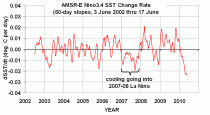
To give some idea of what is causing the global-average SST to fall so rapidly, I came up with an estimate of the change in reflected sunlight (shortwave, or SW flux) using our AMSR-E total integrated cloud water amounts. This was done with a 7+ year comparison of those cloud water estimates to daily global-ocean SW anomalies computed from the CERES radiation budget instrument, also on Aqua (enlarged here):
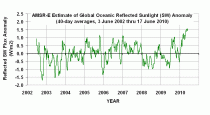
What this shows is an unusually large increase in reflected sunlight over the last several months, probably due to an increase in low cloud cover.
At this pace of cooling, I suspect that the second half of 2010 could ruin the chances of getting a record high global temperature for this year. Oh, darn.
See post and comments here.
-------------
Warming in Last 50 Years Predicted by Natural Climate Cycles
By Dr. Roy Spencer
One of the main conclusions of the 2007 IPCC report was that the warming over the last 50 years was most likely due to anthropogenic pollution, especially increasing atmospheric CO2 from fossil fuel burning.
But a minority of climate researchers have maintained that some - or even most - of that warming could have been due to natural causes. For instance, the Pacific Decadal Oscillation (PDO) and Atlantic Multi-decadal Oscillation (AMO) are natural modes of climate variability which have similar time scales to warming and cooling periods during the 20th Century. Also, El Nino - which is known to cause global-average warmth - has been more frequent in the last 30 years or so; the Southern Oscillation Index (SOI) is a measure of El Nino and La Nina activity.
A simple way to examine the possibility that these climate cycles might be involved in the warming over the last 50 years in to do a statistical comparison of the yearly temperature variations versus the PDO, AMO, and SOI yearly values. But of course, correlation does not prove causation (enlarged here).
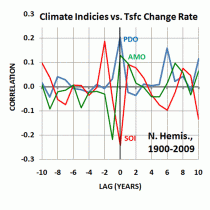
So, what if we use the statistics BEFORE the last 50 years to come up with a model of temperature variability, and then see if that statistical model can “predict” the strong warming over the most recent 50 year period? That would be much more convincing because, if the relationship between temperature and these 3 climate indicies for the first half of the 20th Century just happened to be accidental, we sure wouldn’t expect it to accidentally predict the strong warming which has occurred in the second half of the 20th Century, would we?
Temperature, or Temperature Change Rate?
This kind of statistical comparison is usually performed with temperature. But there is greater physical justification for using the temperature change rate, instead of temperature. This is because if natural climate cycles are correlated to the time rate of change of temperature, that means they represent heating or cooling influences, such as changes in global cloud cover (albedo).
Such a relationship, shown in the plot below, would provide a causal link of these natural cycles as forcing mechanisms for temperature change, since the peak forcing then precedes the peak temperature.
Predicting Northern Hemispheric Warming Since 1960
Since most of the recent warming has occurred over the Northern Hemisphere, I chose to use the CRUTem3 yearly record of Northern Hemispheric temperature variations for the period 1900 through 2009. From this record I computed the yearly change rates in temperature. I then linearly regressed these 1-year temperature change rates against the yearly average values of the PDO, AMO, and SOI.
I used the period from 1900 through 1960 for “training” to derive this statistical relationship, then applied it to the period 1961 through 2009 to see how well it predicted the yearly temperature change rates for that 50 year period. Then, to get the model-predicted temperatures, I simply added up the temperature change rates over time.
The result of this exercise in shown in the following plot (enlarged here).
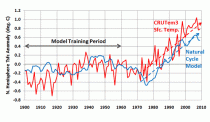
What is rather amazing is that the rate of observed warming of the Northern Hemisphere since the 1970’s matches that which the PDO, AMO, and SOI together predict, based upon those natural cycles’ PREVIOUS relationships to the temperature change rate (prior to 1960).
Again I want to emphasize that my use of the temperature change rate, rather than temperature, as the predicted variable is based upon the expectation that these natural modes of climate variability represent forcing mechanisms - I believe through changes in cloud cover - which then cause a lagged temperature response.
This is powerful evidence that most of the warming that the IPCC has attributed to human activities over the last 50 years could simply be due to natural, internal variability in the climate system. If true, this would also mean that (1) the climate system is much less sensitive to the CO2 content of the atmosphere than the IPCC claims, and (2) future warming from greenhouse gas emissions will be small.
Jun 18, 2010
Glaciers’ wane not all down to humans
By Quirin Schiermeier, Nature News
The Great Aletsch Glacier is ill. Over the course of the twentieth century, the largest Alpine glacier, in Valais, Switzerland, receded by more than two kilometres, and Switzerland’s 1,500 smaller glaciers are not faring any better.

The Great Aletsch Glacier lost about 10 km3 of ice between 1890 (top) and 2005 (bottom).Roger Viollet Collection/Getty Images; G. Fischer/Photolibrary
Is it all down to man-made global warming? Not according to a recent study, which finds that about half of the glacier loss in the Swiss Alps is due to natural climate variability1 - a result likely to be true for glaciers around the world.
“This doesn’t question the actuality, and the seriousness, of man-made climate change in any way,” says Matthias Huss, a glaciologist at the University of Fribourg in Switzerland, who led the study. “But what we do see is that current glacier retreat might be equally due to natural climate variations as it is to anthropogenic greenhouse warming.”
“This is the first detailed attribution of known climate forces on glacier behaviour,” says Georg Kaser, a glaciologist at the University of Innsbruck in Austria, who was not involved in the study. “Given the importance of glaciers to local water supply, this is essential information.”
Researchers have long suspected that glaciers respond sensitively to natural climate swings such as those caused by the rhythmic rise and fall of North Atlantic sea surface temperatures by up to 1 C roughly every 60 years. This Atlantic multidecadal oscillation (AMO), driven by changes in ocean circulation, is thought to affect phenomena including Atlantic hurricanes and rainfall in Europe.
“The idea that glacier retreat is the solely due to increased air temperature is overly simplistic.” In most places, historical records of glacier retreat and local climate are too sparse for researchers to separate the effect of this natural cycle from that of man-made warming. In the relatively well-monitored Swiss Alps, however, Huss and his team managed to gather some 10,000 in situ observations that had been made over the past 100 years, and constructed three-dimensional computer models of 30 glaciers. By comparing a time series of daily melt, snow accumulation and ice and snow volume readings of the glaciers with a widely used index of the AMO, they teased out the impact of natural climate variability. Although the mass balance of individual glaciers varied, the long-term overall trend followed the pulse of the AMO.
Since 1910, the 30 glaciers have lost a total of 13 cubic kilometres of ice - about 50% of their former volume. Brief periods of mass gain during cool AMO phases in the 1910s and late 1970s were outweighed by rapid losses during warm phases in the 1940s and since 1980, when temperatures rose and more precipitation fell as rain than as snow. The scientists believe that these changes are due to the combined effects of the natural cycle and anthropogenic global warming, which now seems to have a greater role than early in the twentieth century.
Subtle mix
Natural climate variability is likely to have driven twentieth-century glacier shrinkage and thinning in other parts of the world, says Kaser. For example, his own research on the glaciers of Mount Kilimanjaro in Tanzania suggests that their dramatic recession is mainly due to multidecadal fluctuations in air moisture2.
“The widespread idea that glacier retreat is the sole consequence of increased air temperature is overly simplistic,” he says. “Glaciologists have known for more than 50 years that glaciers are sensitive to a variety of climate variables, not all of which can be attributed to global warming.”
Questions about the effect of global warming on glaciers hit the headlines earlier this year, after an error was found in the latest assessment report from the Intergovernmental Panel on Climate Change (IPCC), based in Geneva, Switzerland, which wrongly stated that most Himalayan glaciers could disappear by the year 20353. The resulting furore put the IPCC’s credibility under scrutiny, and has triggered an independent review by the InterAcademy Council in Amsterdam, which represents 15 national academies of science.
But scientists don’t expect the latest findings on Swiss glaciers to rekindle the controversy. “Without studies like this, climate science would actually be less credible than it is,” says Martin Beniston, a regional climate modeller at the University of Geneva in Switzerland, who was not involved in the study. “Problems related to global warming are caused by a subtle mix of human activity and natural changes, and these new findings are a rare opportunity to illustrate this complexity in a comprehensible way. It is a question of scientific honesty to admit that not all the effects of climate change are solely the result of increased greenhouse gases.”
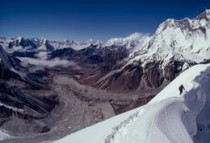
Beniston adds that recognizing the role of natural climate shifts doesn’t diminish the problem. “Even if greenhouse gases contribute just 50% to glacier retreat, this is anything but negligible.” Although Himalayan glaciers may not be as vulnerable as the IPCC report originally suggested, the European Alps, where most glaciers are already in decline, could lose up to 90% of their glaciers by the end of the century, says Kaser.
The authors of the latest study cautiously suggest that a phase shift in the AMO might give a reprieve to Great Aletsch and other Alpine glaciers in the next decades, but Beniston is doubtful. “We may see a temporary slowdown, but I fear in the long run the still fairly modest greenhouse effect will outweigh any Atlantic relief.”
References:
1. Huss, M., Hock, R., Bauder, A. & Funk, M. Geophys. Res. Lett. 37, L10501 (2010). Article
2. Kaser, G., Hardy, D. R., Molg, T., Bradley, R. S. & Hyera, T. M. Int. J. Climatol. 24, 329-339 (2004). Article
3. Schiermeier, Q. Nature 463, 276-277 (2010). Article
Update: See the link of the glaciers to AMO in the paper 100-year mass changes in the Swiss Alps linked to the Atlantic Multidecadal Oscillation here.
|










